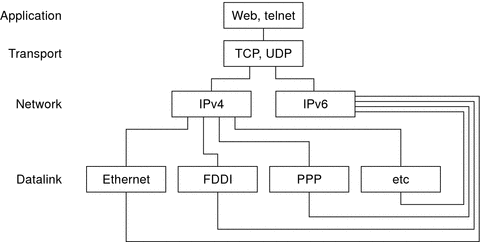Dual-Stack Protocols
The term dual-stack normally refers to a complete duplication of all levels in
the protocol stack from applications to the network layer. One example of complete
duplication is a system that runs both the OSI and TCP/IP protocols.
The Solaris OS is dual-stack, meaning that the Solaris OS implements both IPv4
and IPv6 protocols. When you install the operating system, you can choose to
enable the IPv6 protocols in the IP layer or use only the default
IPv4 protocols. The remainder of the TCP/IP stack is identical. Consequently, the same
transport protocols, TCP UDP and SCTP, can run over both IPv4 and IPv6.
Also, the same applications can run over both IPv4 and IPv6. Figure 11-4 shows
how the IPv4 and IPv6 protocols work as a dual-stack throughout the various
layers of the Internet protocol suite.
Figure 11-4 Dual-Stack Protocol Architecture

In the dual-stack scenario, subsets of both hosts and routers are upgraded to
support IPv6, in addition to IPv4. The dual-stack approach ensures that the upgraded
nodes can always interoperate with IPv4-only nodes by using IPv4.
